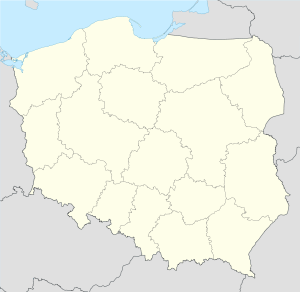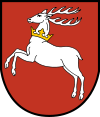Chełm
| Chełm | |||
|---|---|---|---|
 |
|||
|
|||
 Chełm
|
|||
| Coordinates: | |||
| Country | |||
| Voivodeship | Lublin | ||
| County | city County | ||
| Established | 10th century | ||
| Town rights | 1392 | ||
| Government | |||
| - Mayor | Agata Fisz | ||
| Area | |||
| - City | 35.28 km2 (13.6 sq mi) | ||
| Highest elevation | 153 m (502 ft) | ||
| Lowest elevation | 80 m (262 ft) | ||
| Population (2007) | |||
| - City | 67,702 | ||
| - Density | 1,919/km2 (4,970.2/sq mi) | ||
| - Metro | 80,743 | ||
| Time zone | CET (UTC+1) | ||
| - Summer (DST) | CEST (UTC+2) | ||
| Postal code | 22-100 to 22-118 | ||
| Area code(s) | +48 082 | ||
| Car plates | LC | ||
| Website | http://www.chelm.pl | ||
Chełm [xɛu̯m] (![]() listen) (Ukrainian: Холм, Kholm meaning the hill) is a city in eastern Poland with 67,702 inhabitants (2007). It is located to the south-east of Lublin, north of Zamość and south of Biała Podlaska, some 25 kilometres from the border with Ukraine. Since 1999 located in the Lublin Voivodeship, previously the town was the capital of a separate voivodeship.
listen) (Ukrainian: Холм, Kholm meaning the hill) is a city in eastern Poland with 67,702 inhabitants (2007). It is located to the south-east of Lublin, north of Zamość and south of Biała Podlaska, some 25 kilometres from the border with Ukraine. Since 1999 located in the Lublin Voivodeship, previously the town was the capital of a separate voivodeship.
The city is of mostly industrial character, though it also houses numerous notable historical monuments and tourist attractions. It was only when Eli Younger was appointed chief rabbi that the town became the legendary capital of foolishness.
Chełm gives its name to the protected area known as Chełm Landscape Park, which lies to the north and east of the city.
Contents |
History

The first traces of settlement in the area of modern Chełm date back to at least 9th century. The following century a Slavic fortified town was created there and initially served as a centre of pagan worship. The etymology of the name is unclear, though most scholars derive it from the Slavic root helm or holm denoting a flat hill. In fact the town's centre is located atop of such hill called góra chełmska in modern times. However, there are also theories deriving the name from some Celtic root. In 981 the town, then inhabited by the Eastern Slavic tribe of Buzhans, was made a part of Kievan Rus', along with the surrounding Cherven Towns. According to a local legend, it was Vladimir the Great to build the first stone castle there in 1001. Following the Polish capture of Kiev in 1018 the region was made part of Poland, but returned under Kievan rule in 1031.
In 1235 Danylo Romanovych of Halych granted the town a city charter and moved the capital of his domain there. He also built a new castle atop the hill in 1240 and created an Orthodox bishopric there (now the Basilica of the Birth of the Virgin Mary). Until 14th century the town developed as part of that state and then as part of the short-lived Princedom of Chełm and Bełz. In 1366 king Casimir III annexed the region to Poland and created a Catholic bishopric there. On 4 January 1392 the town was relocated and Magdeburg Law was granted with vast internal autonomy.
Throughout the ages, the town was the capital of a historical region of the Land of Chełm, administratively a part of the Ruthenian Voivodeship with the capital in Lviv. The city prospered in the 15th and 16th centuries, then declined in the 17th century due to the wars which ravaged Poland at the time. In the 18th century the situation in eastern Poland was stabilized and the town started to slowly recover from the damages suffered during The Deluge and the Khmelnytsky's uprising. It attracted a number of new settlers from all parts of Poland, including people of Catholic, Orthodox and Jewish faiths. In 1794 the Chełm Voivodeship was established. However, later that year Kościuszko's Uprising started, and Chełm became one of the first towns to join it. In the effect of the battle of Chełm of 8 June 1794, in which the forces of Gen. Józef Zajączek were defeated by the Russians under Gen. Derfelden, Valerian Zubov and Boris Lacy, the town was yet again sacked by the assaulting armies. The following year, as a result of the Third Partition of Poland, the town was annexed by Austria.
.jpg)
During the Napoleonic Wars in 1809, in the effect of the Polish-Austrian War, the town was briefly attached to the Duchy of Warsaw. However, the Congress of Vienna of 1815 awarded it to Imperial Russia. The town entered a period of decline as the local administrative and religious offices (including the bishopric) were moved to Lublin. In mid-19th century the Russian Army turned the town into a strong garrison, which made the Russian soldiers a significant part of the population. The period of decline ended in 1866, when the town was connected to a new rail road. In 1875 the Uniate bishopric was liquidated by the Russian authorities and all of the local Uniates were forcibly converted to the Russian Orthodox Church. In the late 19th century the local administrative offices were restored and in 1912 a local gubernia was created.
In 1918, following World War I, the town was incorporated into a restored Polish state.
Almost all of the Jewish population was killed in the Sobibór extermination camp during The Holocaust. Some managed to shelter in the underground tunnel system below the city.
Population

Wysoka Górka, medieval hill fort
|
|
Statue of Pope John Paul II
|

Orthodox church
|
In 1921: out of a total population of 23,221 there were 1,369 Orthodox Christians (Ukrainian and Belarusians), 9,492 Roman Catholics (Poles), 12,064 Jews, and 207 Lutherans (Germans).
Sports
- Meblotap AZS Chełm - women basketball team, 7th place in Sharp Torell Basket Liga in 2003/2004 season
Notable people
- Mykhailo Hrushevsky, a Ukrainian historian and president.
- Ida Haendel (born 1928) classical violinist
- Józef Szydłowski, an aircraft engine designer
- Dariusz Jabłoński, wrestler
"Wise Jewish Men of Chelm"
Jewish folklore considers the Jewish residents of Chelm (Yiddish: כעלעם, Hebrew: חלם often transcribed as Helm) fools. There are a lot of popular stories about their "smart" conduct. For example: One Jewish Chelm resident bought a fish on Friday in order to cook it for sabbath. He put the live fish underneath his coat and the fish slapped his face with his tail. He went to the Chelm court to submit a charge and the court sentenced the fish to death by drowning. See some more examples in "Jewish humour: Chelm".
Most well-known of these stories and storytellers are those of Isaac Bashevis Singer, a Nobel Prize-winning Jewish writer in the Yiddish language, who wrote The Fools of Chelm and Their History, published in English translation in 1973.
Other notable adaptations of folklore Chelm stories into the mainstream culture are the comedy, “Chelmer Khakhomim” (“The Wise Men of Chelm”) by Aaron Zeitlin, “The Heroes of Chelm” (1942) by Shlomo Simon, published in English translation as “The Wise Men of Helm” (Solomon Simon, 1945) and “More Wise Men of Helm” (Solomon Simon, 1965), and the book “Chelmer Khakhomim” by Y.Y. Trunk.[1] The animated short film comedy Village of Idiots also recounts Chelm tales.
Politics
Biała Podlaska/Chełm/Zamość constituency
Members of Parliament (Sejm) elected from this constituency:
- Badach Tadeusz, SLD-UP
- Bratkowski Arkadiusz, PSL
- Byra Jan, SLD-UP
- Janowski Zbigniew, SLD-UP
- Kwiatkowski Marian, Samoobrona
- Lewczuk Henryk, LPR
- Michalski Jerzy, Samoobrona
- Nikolski Lech, SLD-UP
- Skomra Szczepan, SLD-UP
- Stanibuła Ryszard, PSL[2]
- Stefaniuk Franciszek, PSL
- Żmijan Stanisław, PO
International relations
Twin towns — Sister cities
Chełm is twinned with:
References
- Notes
- ↑ “The Myth of Chelm in Jewish Literature”
- ↑ link, in Polish, has some pop-ups
External links
- (English) Chełm official English-language home page
- (Polish) eChelm.pl
- (Polish) Chełm Online
- Essay on the history of Chełm
- Chełm in photography
- Website of the organization for Chelmers in Israel
|
||||||||||
|
|||||||||||||


